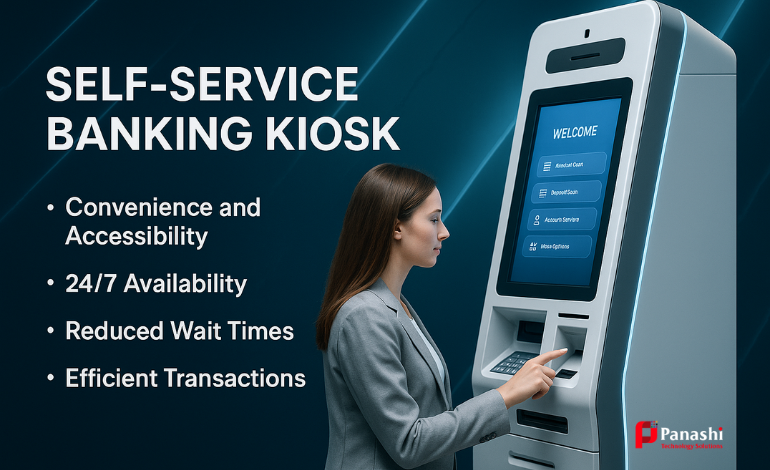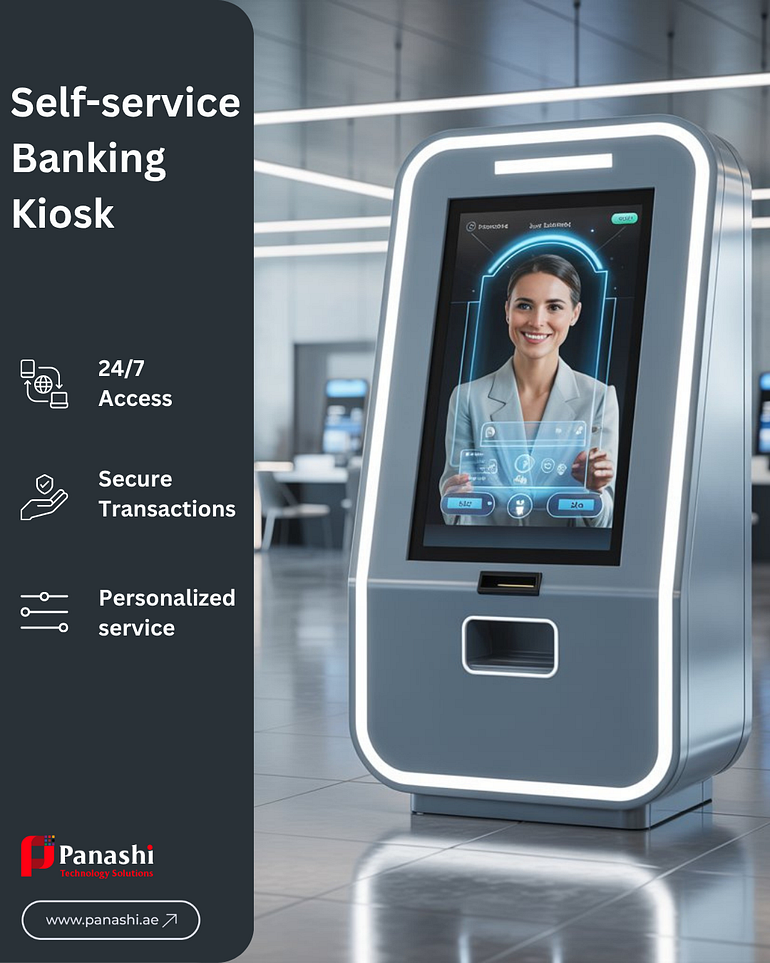- Get link
- X
- Other Apps
- Get link
- X
- Other Apps

The world of banking has undergone a remarkable transformation over the last few decades. From the days of queuing up in traditional bank branches to the modern convenience of self-service kiosks, the evolution reflects not only technological advancement but also changing customer expectations. While bank branches were once the sole point of financial interaction, today’s consumers demand speed, accessibility, and autonomy in managing their finances.
In this blog, we explore how traditional bank branches and modern banking kiosks differ, the strengths and weaknesses of each, and why this comparison is increasingly relevant. With banks worldwide redefining their service models, understanding both systems is crucial for industry stakeholders, financial institutions, and customers.
Overview of Traditional Bank Branches
What Are Traditional Bank Branches?
Traditional bank branches are physical locations where customers interact face-to-face with bank personnel to conduct a range of financial services. These branches have historically served as the cornerstone of banking infrastructure, fostering trust, security, and relationship-based service.
Established as far back as the 17th century, branches symbolized a bank’s legitimacy and stability. Their presence in towns and cities played a critical role in financial inclusion, offering communities access to vital banking services.
Services Offered by Traditional Bank Branches
Traditional branches provide a comprehensive range of banking services, including:
- Opening and managing bank accounts
- Depositing and withdrawing cash
- Processing cheques
- Offering loan and mortgage consultations
- Investment and wealth management services
- Safe deposit box rentals
- Customer service support and issue resolution
This one-stop solution has long been favored for its holistic approach and human touch.
Advantages of Traditional Bank Branches
Some notable benefits of physical branches include:
- Personalized Service: Customers can receive in-depth advice tailored to their financial goals.
- Trust and Security: Face-to-face transactions provide reassurance and accountability.
- Complex Transactions: Ideal for handling complex or large-scale transactions that require documentation or consultation.
- Relationship Banking: Customers can develop long-term relationships with banking professionals.
Limitations of Traditional Bank Branches
Despite their benefits, traditional branches come with several drawbacks:
- Limited Hours: Most branches operate during standard business hours, which may not suit everyone.
- Geographic Constraints: Not all customers live near a bank, especially in rural areas.
- Higher Operational Costs: Staffing, rent, and utilities contribute to higher service delivery costs.
- Long Wait Times: During peak hours, customers often face long queues and wait times.
Introduction to Banking Kiosks
What Are Banking Kiosks?
Banking kiosks are self-service terminals that enable customers to perform various banking transactions without the need for human assistance. These can range from advanced ATMs (Automated Teller Machines) to more sophisticated kiosks capable of offering broader services.
As banking becomes increasingly digitized, kiosks serve as a bridge between traditional banking and full-fledged digital banking. They’re typically placed in accessible public locations such as malls, airports, supermarkets, or even rural areas.
Services Provided by Banking Kiosks
Depending on their configuration, banking kiosks can offer services such as:
- Cash withdrawal and deposits
- Bill payments (utilities, credit cards, etc.)
- Account balance checks and mini-statements
- Fund transfers between accounts
- Account opening with digital KYC
- Card replacement or PIN change
Benefits of Banking Kiosks
The appeal of banking kiosks lies in their:
- 24/7 Availability: Many kiosks are accessible around the clock.
- Cost Efficiency: Lower operational costs compared to full-scale branches.
- Speed and Convenience: Ideal for simple, quick transactions.
- Accessibility: Helps banks expand their reach to underserved or remote areas without investing in full branches.
- Reduced Queue Times: Customers avoid long lines associated with traditional branches.

Challenges and Limitations of Banking Kiosks
Despite their convenience, kiosks come with their own set of challenges:
- Limited Scope: Not suitable for complex transactions or financial planning.
- Technical Glitches: Machine downtimes or user interface issues can hinder usability.
- Security Concerns: Risk of card skimming, data theft, or vandalism.
- Learning Curve: Elderly or less tech-savvy users may struggle with the interface.
Comparative Analysis of Traditional Bank Branches and Banking Kiosks
To assess which model fits the modern consumer’s needs better, we need to analyze their performance across several critical parameters.
Customer Experience and Personal Interaction
Traditional branches excel in offering personalized, face-to-face interaction, which is crucial for building trust and addressing complex financial issues. Human interaction also allows for nuanced communication, which is especially important for services like mortgage planning or investment advisory.
On the other hand, kiosks offer limited to no human contact. They are efficient for routine transactions but fall short in handling unique or complicated customer needs. However, younger generations may prefer this minimal interaction model for its speed and simplicity.
Cost and Operational Efficiency
From an operational standpoint, kiosks are far more cost-effective. A single kiosk can serve hundreds of users daily with minimal maintenance and no staffing costs. This allows banks to save significantly on infrastructure, utilities, and salaries.
Branches, in contrast, are expensive to maintain. However, they may justify the cost for high-value services and customer loyalty initiatives.
Accessibility and Convenience
Kiosks clearly outperform in terms of convenience. Available in malls, railway stations, and even rural outposts, kiosks are designed for accessibility. Their 24/7 operation ensures customers can bank at their own convenience.
Branches, while limited by geography and operating hours, still hold value in communities with low digital penetration or for customers who prefer traditional banking modes.
Technology and Security Considerations
Modern kiosks come equipped with advanced security features like biometric authentication, encryption, and surveillance. However, they are also more vulnerable to specific types of cyber threats, requiring constant updates and security audits.
Traditional branches benefit from in-person identity verification and physical security but are not immune to fraud and data breaches, particularly in their internal systems.
Future Trends in Banking: Integration of Branches and Kiosks
Rather than choosing between branches or kiosks, many banks are blending the two to create a more agile and responsive customer service model.
Hybrid Banking Models
Banks are increasingly deploying hybrid models that combine the personalized services of traditional branches with the efficiency of self-service kiosks. For instance, a bank branch may install kiosks within its premises to handle routine transactions, freeing staff to focus on value-added services.
This approach provides the best of both worlds — reducing wait times and operating costs while still offering human support when needed.
Impact of Digital Transformation on Banking Infrastructure
Digital transformation is driving banks to rethink infrastructure strategies. AI-powered kiosks with voice assistance, touchscreen interfaces, and real-time video chat support are already making waves. Cloud banking and API integration further enhance the backend, ensuring real-time data syncing and enhanced analytics.
Branches, too, are getting a tech facelift with digital displays, appointment scheduling systems, and paperless documentation.
Customer Preferences and Behavioral Shifts
Today’s customers are digitally savvy, value convenience, and prefer quick, on-the-go solutions. While Baby Boomers may still favor in-branch services, Millennials and Gen Z expect a digital-first approach.
As customer preferences continue to evolve, banks must offer multi-channel experiences that include physical, digital, and hybrid solutions.
Conclusion
The evolution of banking from traditional branches to modern kiosks reflects a larger shift in consumer expectations and technological capabilities. Traditional bank branches continue to play an essential role in providing complex services and building customer relationships. However, banking kiosks are fast emerging as a cost-effective, convenient, and accessible solution for everyday transactions.
Rather than viewing one as a replacement for the other, banks should focus on integrating both models. By doing so, they can cater to a broader demographic, improve operational efficiency, and stay relevant in a fast-changing financial ecosystem.
As we look to the future, a blended approach combining human interaction and technological convenience will define the next chapter of customer-centric banking.
- Get link
- X
- Other Apps
Comments
Post a Comment